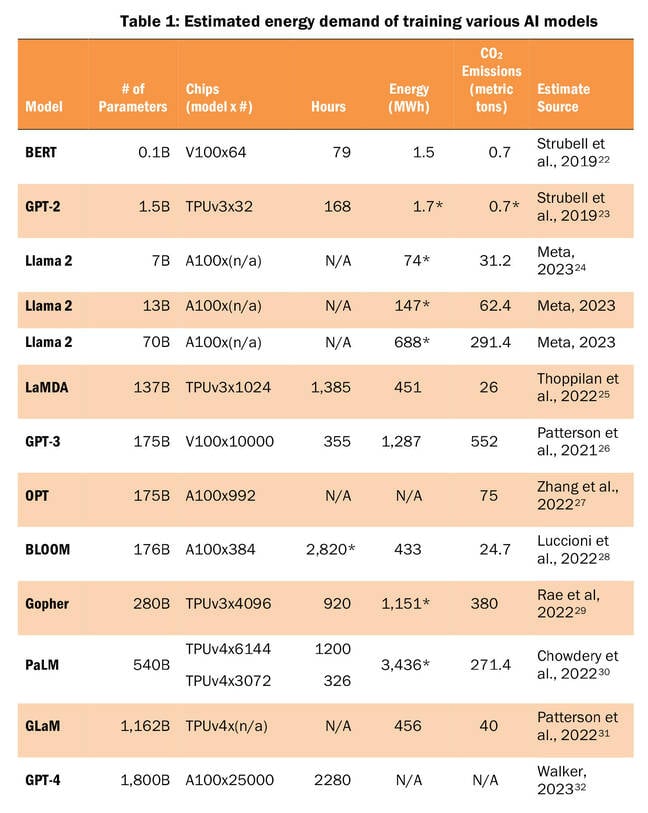[ad_1]
It is nicely established that the tens of hundreds of GPUs used to coach giant language fashions (LLMs) devour a prodigious quantity of vitality, resulting in warnings about their potential affect on Earth’s local weather.
Nevertheless, in line with the Data Expertise and Innovation Basis’s Middle for Knowledge Innovation (CDI), a Washington DC-based suppose tank backed by tech giants like Intel, Microsoft, Google, Meta, and AMD, the infrastructure powering AI isn’t a significant menace.
In a current report [PDF], the Middle posited that lots of the considerations raised over AI’s energy consumption are overblown and draw from flawed interpretations of the info. The group additionally contends that AI will possible have a constructive impact on Earth’s local weather by changing much less environment friendly processes and optimizing others.
“Discussing the vitality utilization traits of AI programs could be deceptive with out contemplating the substitutional results of the expertise. Many digital applied sciences assist decarbonize the financial system by substituting transferring bits for transferring atoms,” the group wrote.
The Middle’s doc factors to a examine [PDF] by Cornell College that discovered utilizing AI to jot down a web page of textual content created CO2 emissions between 130 and 1,500 instances lower than these created when an American carried out the identical exercise utilizing a normal laptop computer – though that determine additionally contains carbon emissions from residing and commuting. A better take a look at the figures, nonetheless, present they omit the 552 metric tons of CO2 generated by coaching ChatGPT within the first place.
The argument could be made that the quantity of energy used to coaching an LLM is dwarfed by what’s consumed by deploying it — a course of known as inferencing — at scale. AWS estimates that inferencing accounts for 90 p.c of the price of a mannequin, whereas Meta places it at nearer to 65 p.c. Fashions are additionally retrained occasionally.
The CDI report additionally means that simply as a sensible thermostat can cut back a house’s vitality consumption and carbon footprint, AI may obtain comparable efficiencies by preemptively forecasting grid demand. Different examples included utilizing AI to make how a lot water or fertilizer farmers ought to use for optimum effectivity, or monitoring methane emissions from satellite tv for pc knowledge.
In fact, for us to know whether or not AI is definitely making the state of affairs higher, we have to measure it, and in line with CID there’s loads of room for enchancment on this regard.
Why so many estimates get it mistaken
Based on the Middle for Knowledge Innovation, this is not the primary time expertise’s vitality consumption has been met with sensationalist headlines.
The group pointed to 1 declare from the height of the dot-com period that estimated that the digital financial system would account for half the electrical grid’s sources inside a decade. A long time later and the Worldwide Vitality Company (IEA) estimates that datacenters and networks account for simply 1-1.5 p.c of world vitality use.
That’s a beautiful quantity for the Middle’s backers, whose numerous deeds have earned them years of antitrust motion that imperils their social license.
However it’s additionally a quantity that’s laborious to take at face worth, as a result of datacenters are advanced programs. Measuring the carbon footprint or vitality consumption of one thing like coaching or inferencing an AI mannequin is subsequently susceptible to error, the CDI examine contends, with out irony.
One instance highlighted cites a paper by the College of Massachusetts Amherst that estimates the carbon footprint of Google’s BERT pure language processing mannequin. This data was then used to estimate the carbon emissions from coaching a neural structure search mannequin which rendered a results of 626,155 kilos of CO2 emissions.
The findings have been extensively revealed within the press, but, a later examine confirmed the precise emissions have been 88 instances smaller than initially thought.
The place estimates are correct, the report contends that different elements, like the combo of renewable vitality, the cooling tech, and even the accelerators themselves, imply they’re solely actually consultant of that workload at that place and time.
The logic goes one thing like this: In case you practice the identical mannequin two years later utilizing newer accelerators, the CO2 emissions related to that job would possibly look fully completely different. This consequently implies that a bigger mannequin will not essentially devour extra energy or produce extra greenhouse gasses as a byproduct.
There are just a few causes for this however one among them is that AI {hardware} is getting quicker, and one other is that the fashions that make headlines might not all the time be probably the most environment friendly, leaving room for optimization.

From this chart, we see that extra fashionable accelerators, like Nvidia’s A100 or Google’s TPUv4 have a bigger affect on emissions than parameter measurement. – Click on to enlarge
“Researchers proceed to experiment with methods equivalent to pruning, quantization, and distillation to create extra compact AI fashions which might be quicker and extra vitality environment friendly with minimal lack of accuracy,” the writer wrote.
The CID report’s argument seems to be that previous makes an attempt to extrapolate energy consumption or carbon emissions have not aged nicely, both as a result of they make too many assumptions, are primarily based on flawed measurements, or they fail to have in mind the tempo of {hardware} or software program innovation.
Whereas there’s advantage to mannequin optimization, the report does appear to miss the actual fact Moore’s Legislation is slowing down and that generational enhancements in efficiency aren’t anticipated to carry matching vitality effectivity upticks.
Bettering visibility, avoiding regulation, and boosting spending
The report presents a number of ideas for a way policymakers ought to reply to considerations about AI’s vitality footprint.
The primary entails creating requirements for measuring the ability consumption and carbon emissions related to each AI coaching and inferencing workloads. As soon as these have been established, the Middle for Knowledge Innovation means that policymakers ought to encourage voluntary reporting.
“Voluntary” seems to be the important thing phrase right here. Whereas the group says it is not against regulating AI, the writer paints a Catch-22 during which attempting to control the business is a lose-lose state of affairs.
“Policymakers hardly ever take into account that their calls for can elevate the vitality necessities to coach and use AI fashions. For instance, debiasing methods for LLMs incessantly add extra vitality prices within the coaching and fine-tuning levels,” the report reads. “Equally implementing safeguards to test that LLMs don’t return dangerous output, equivalent to offensive speech, can lead to further compute prices throughout inference.”
In different phrases, attempting to mandate safeguards and also you would possibly make the mannequin extra energy hungry; mandate energy limits and danger making the mannequin much less secure.
Unsurprisingly, the ultimate suggestion requires governments, together with the US, to put money into AI as a solution to decarbonize their operations. This contains using AI to optimize constructing, transportation, and different city-wide programs.
“To speed up using AI throughout authorities companies towards this objective, the president ought to signal an govt order directing the Expertise Modernization Fund… embrace environmental affect as one of many precedence funding areas for initiatives to fund,” the group wrote.
In fact all of that is going to require higher GPUs and AI accelerators, both bought instantly or rented from cloud suppliers. That is excellent news for expertise firms, which produce and promote the instruments essential to run these fashions.
So it isn’t shocking, Nvidia was eager to spotlight the report in a current weblog publish. Nvidia has seen its revenues skyrocket in current quarters as demand for AI {hardware} reaches a fever pitch. ®
[ad_2]


